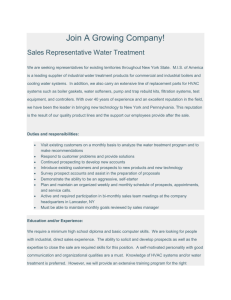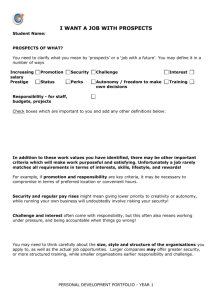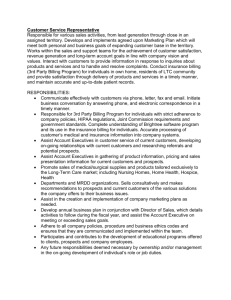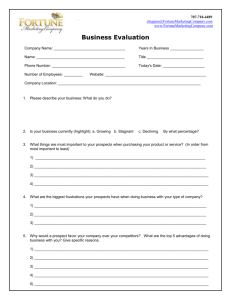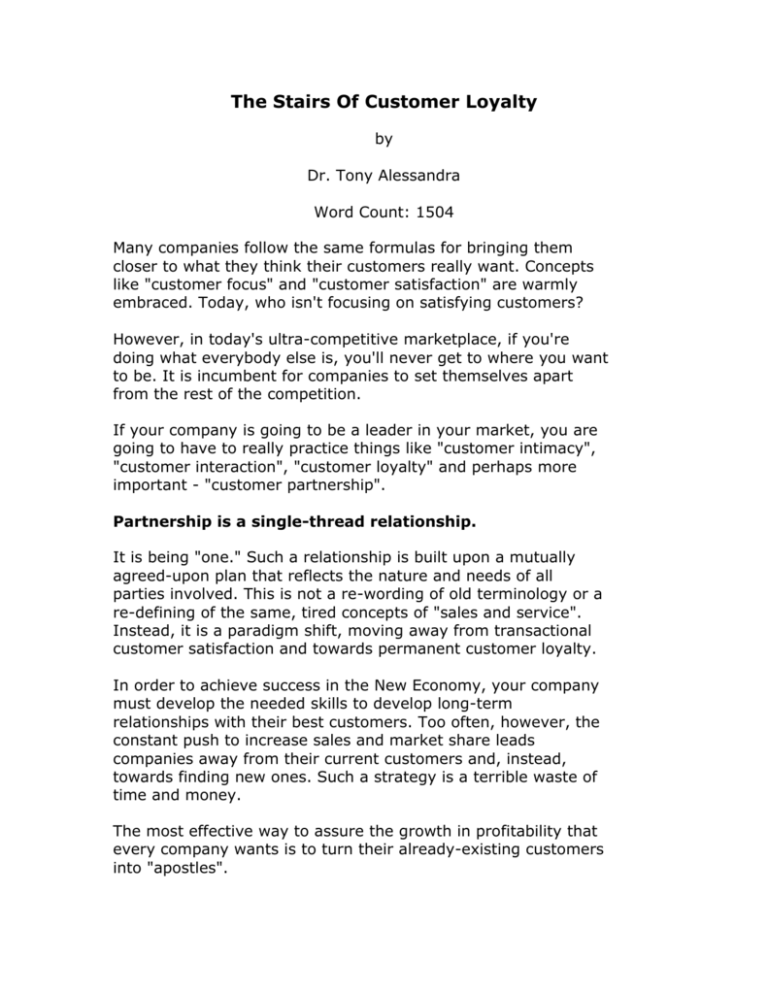
The Stairs Of Customer Loyalty
by
Dr. Tony Alessandra
Word Count: 1504
Many companies follow the same formulas for bringing them
closer to what they think their customers really want. Concepts
like "customer focus" and "customer satisfaction" are warmly
embraced. Today, who isn't focusing on satisfying customers?
However, in today's ultra-competitive marketplace, if you're
doing what everybody else is, you'll never get to where you want
to be. It is incumbent for companies to set themselves apart
from the rest of the competition.
If your company is going to be a leader in your market, you are
going to have to really practice things like "customer intimacy",
"customer interaction", "customer loyalty" and perhaps more
important - "customer partnership".
Partnership is a single-thread relationship.
It is being "one." Such a relationship is built upon a mutually
agreed-upon plan that reflects the nature and needs of all
parties involved. This is not a re-wording of old terminology or a
re-defining of the same, tired concepts of "sales and service".
Instead, it is a paradigm shift, moving away from transactional
customer satisfaction and towards permanent customer loyalty.
In order to achieve success in the New Economy, your company
must develop the needed skills to develop long-term
relationships with their best customers. Too often, however, the
constant push to increase sales and market share leads
companies away from their current customers and, instead,
towards finding new ones. Such a strategy is a terrible waste of
time and money.
The most effective way to assure the growth in profitability that
every company wants is to turn their already-existing customers
into "apostles".
For far too many companies today, the overriding focus of their
growth strategy is on increasing sales and market share. This is
eerily similar to what I experienced when I was working my way
through college selling cookware door to door. As a beginning
salesperson, I naively believed the best way for me to make
more money was to make more sales.
The foolish dedication to this premise led me to ignore my past
customers in favor of always finding new ones. It was only
afterwards, when I found myself working harder than ever
before and making less money for the time I invested, that I
realized my strategy was wrong. Unfortunately, many companies
today are acting and thinking like I did over thirty years ago.
They dedicate far more of their resources to expanding sales at
the expense of their already existing clientele.
Since 1974, while working with some of the smartest and most
successful companies across America, I have learned that the
ability to convert new sales into "apostles" for the company is
the best path towards stable, long-term growth. Moreover, I
have recognized which skills are needed to accomplish this task.
The stairs of customer loyalty is the process which, in a simple,
straightforward manner, shows you how to convert your
prospects into sales, and then to customers, and finally, into
apostles, who are a group of raving fans who will "preach your
message" and "sing your praises" to the marketplace.
Finding the Right Prospects and Avoiding the Wrong
Prospects
Possessing the right marketing skills is crucial in properly
identifying the right kinds of prospects for a company. Smart
companies accomplish this responsibility by profiling the top
twenty percent of their current customers who typically provide
eighty percent of their profits.
Criteria like profitability, frequency of purchase, after-sales
service required, revenue, and loyalty potential are quantified
and used as measuring devices in determining the most
important characteristics of a company's best, most potentially
loyal customers.
Looking for new business is very expensive. Therefore,
companies need to avoid the wrong kinds of prospects for them.
Just as it is critical in distinguishing the attributes of the right
prospects, a company needs to outline the characteristics that
make-up the bottom twenty percent of their customer base.
Anybody in business can easily recognize whom the complainers,
price-grinders, and transaction-oriented clients are. By clearly
understanding the bad traits of those bottom twenty-percent,
companies can much easier avoid the wrong prospects and focus
their resources on the upper twenty-percent instead.
The "20/80 Rule" works at the bottom of the customer
base as well. That is, twenty percent of a company's customers
more than likely cost more to handle than they're worth. These
customers give more grief; chew up more time with requests
and complaints; and, generally, cause the most stress for a
company.
The Steps to Successful Sales
When a company is ready to make contact with the right type of
prospect, three face-to-face steps are used to move to the next
stair, "making the sale". Each step requires particular selling
skills that are necessary to "close the sale". A successful sale is
like building a pyramid; each step depends upon the success of
the previous ones, and no step can be omitted without creating
disaster.
Exploring Needs
The exploring step of sales gives you the chance to get deeply
involved with your prospects to determine exactly how your
product or service can help them. It's where the partnering
process begins. The purpose of exploring is to get enough
information from the client to enable you to recommend
appropriate options. This step is epitomized by the guiding
principle of Collaborative Selling, "Prescription before diagnosis is
malpractice."
Collaborating Solutions
After you've worked with your prospects to identify needs and
concerns, the next step is to determine whether or not your
product or service will solve a problem or seize an opportunity
for them. Usually there are several different ways you can put
your product or service together to meet the needs of your
prospects.
The collaborative selling way is much less adversarial and much
easier. You actually involve your prospects in deciding which one
of your options makes the most sense for them.
Confirming the Sale
If you've done your job properly to this point, your customer
should be asking to buy from you. The commitment becomes a
how and a when, not an if. Signing the agreement is merely a
formality. However, before confirming the sale, you'll want to be
sure your prospect has all the information he needs to increase
their perceived value of your product or service.
Building Long-Term Customers: Operations-Driven vs.
Customer-Driven
Leaders in their industries are always customer-driven, instead
of operations-driven. Through the keen application of service
skills, smart companies design strategies that assure that
customer expectations are consistently identified, managed, and
monitored. Then, once these are accomplished, exceeding
customer expectations becomes the compelling focus.
Companies that apply the correct service skills create moments
of magic for their customers, rather than moments of misery.
Moments of Misery vs. Moments of Magic
Any occasion a customer comes into contact with any aspect of
your company is actually of moment of truth for your
organization. When the customer encounters a member of your
staff, a piece of advertising, or any thing else that can be tied to
your company, they formulate opinions, beliefs, impressions,
and ideas about who you are and what you're about. These
moments of truth normally result in one of three outcomes: a
Moment of Misery, a Moment of Mediocrity, or a Moment of
Magic.
Customers who consistently have their expectations exceeded -
or, receive Moments of Magic - are those who become apostles
for your organization.
Converting Customers into Apostles
Exceptionally strong intimacy with the customer characterizes
the apostle stair of customer loyalty. Creating apostles should be
the highest goal of customer development. Apostles will do more
for your organization through their good will and word of mouth
than almost any other form of marketing or sales. Smart
companies look to double the number of apostles each year by
moving prospects, sales, and customers up the stairs of
customer loyalty.
Apostle-Driven
Companies that become "Apostle-Driven" are those that do not
constantly have to dedicate limited resources of time and money
to always finding new customers. Their Apostles accomplish this
task for them. Such leading companies, of which there are far
too few, are the ones that will dominate their industries now and
well into the new century.
The Stairs of Customer Loyalty shows you how to consciously
shape a plan for developing your customer relationship skills in a
more congruent manner and is a benchmark in fostering and
promoting permanent customer relationships for businesses of
all sizes. The Stairs of Customer Loyalty helps you recognize the
wide range of challenges facing your company today and
provides the skills indispensable for overcoming them so you can
achieve the critical relationships needed to survive and thrive in
the new millennium.
Dr. Tony Alessandra, CSP, CPAE has authored 13 books,
recorded over 50 audio and video programs, and delivered over
2,000 keynote speeches since 1976. This article has been
adapted from Dr. Alessandra's book, Charisma (Warner books,
1998. Dr. Tony Alessandra is recognized by Meetings and
Conventions Magazine as... "one of America's most electrifying
speakers." Copyright© 2002, Tony Alessandra. All rights
reserved. For information about Tony’s keynote presentations,
contact the Frog Pond Group at 800.704.FROG(3764) or email
susie@frogpond.com; http://www.frogpondgroup.com

